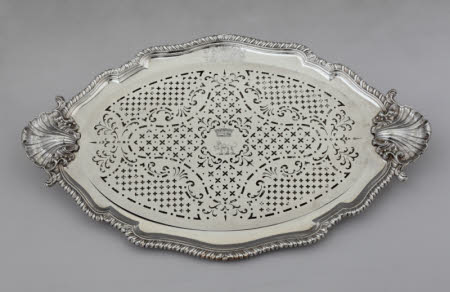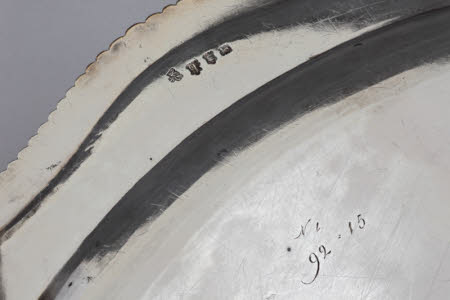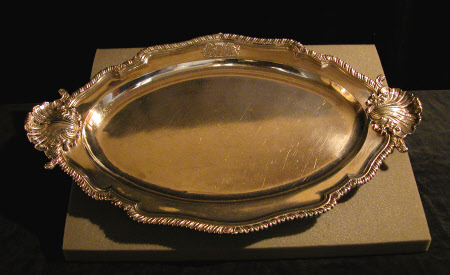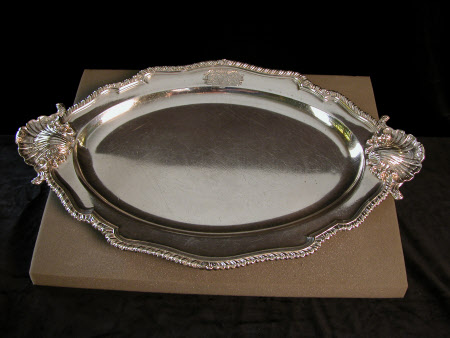Large oval dish
Frederick Kandler
Category
Silver
Date
1751 - 1752
Materials
Sterling silver
Measurements
5.1 x 59.4 x 36.5 cm
Place of origin
London
Order this imageCollection
Ickworth, Suffolk
NT 852080.3
Summary
Large oval dish, sterling silver, by Frederick Kandler, London, 1751/2. One of two, associated with mazarines of the same date (NT 852080.2 & 4). The dish is raised and has a flat oval well and a broad rim with a shaped border applied with cast and chased gadrooning. Two large cast and chased shells are applied as handles. Heraldry: Engraved on the rim of the dish are the quartered shield, supporters and motto of the 2nd Earl of Bristol in an ermine mantling and beneath an earl’s coronet.
Full description
For service à la française, which held sway until the mid nineteenth century, dishes were supplied in gradated sizes and arranged on the table for diners to help themselves to the food thereon. In the decades around 1700 the dishes were generally of circular shape as is made abundantly clear by surviving examples [1] and also by the table layouts given by François Massialot in his Nouveau cuisinier royal et bourgeois, first published in 1691 and translated into English as The court and country cook in 1702.[2] Oval dishes were not unknown [3] but they seem to have been rare and it was only in the 1730s that significant numbers began to appear in England.[4] They were shown in the plates of Vincent La Chapelle’s highly influential The modern cook of 1733, some with shaped borders,[5] and by 1740 they were becoming commonplace, often augmented by gadrooning as seen on the Ickworth examples. An exceptionally early group of oval shaped dishes, with elaborate Régence decoration, is that of 1731 made by Charles Kandler for the 9th Duke of Norfolk.[6] They exhibit diminutive cast shells protruding at either end, presumably there in part to assist with lifting the dishes as were the flanges of 1720s epergne dishes (see cat. 13). It could thus have been from the Kandler workshop that the idea emanated of more prominent shell handles as seen on the Ickworth dishes, though they were more probably directly inspired by Continental ecuelles [7] and their English equivalents, porringers. A good example of the latter with prominent shell handles is a pair by David Willaume marked for 1721 at Winterthur.[8] The earliest dishes extant of the Ickworth type are all of 1741, a large batch (some circular) by Paul de Lamerie and a pair by George Wickes.[9] The shell handles on these are very similar but not identical, that employed by Wickes being more symmetrically arranged and having lateral fronds projecting beyond the border plus trios of pearl-like balls. It is the Wickes model that was used by Edward Wakelin in 1748 for Admiral Byng’s dinner service [10] and by Kandler from 1751 onwards for all of Lord Bristol’s larger dishes. Thus the two most prominent retailers of the mid-century were either sourcing from the same outworkers or sharing moulds, and a third option might even be that Kandler had simply taken a cast from a Wickes dish. The feature was to prove a resilient one, being further copied in the early nineteenth century by Rundell, Bridge and Rundell for the dinner service provided to William IV,[11] and in that case the inspiration is very likely to have been the Bristol plate (see NT 852103) which Rundells had had access to. It is evident from wear and tear that the Ickworth dishes were not exclusively used with the fish plates or mazarines with which they were supplied (NT 852080.2 & 4) but the need to ensure that they fitted when thus employed is probably why, unlike the other eight oval dishes of c.1751 (NT 852095.1-2 & 7-8 and 852096), these ones were new-made. As the largest of all the sizes of dish they would have contained the principal focus of the first and second courses, other than the soups. When being used for fish they might, for instance, have contained a turbot and a salmon to replace the two principal soup tureens as part of the first course. For the second they could take the same place, Vincent La Chapelle suggesting Savoy Cake and ‘a Cake of mille Feuilles’. Alternatively, if used for meat, they might contain a quarter of veal or a roasted ham.[12] James Rothwell, Decorative Arts Curator February 2021 [Adapted from James Rothwell, Silver for Entertaining: The Ickworth Collection, London 2017, cat. 32, pp. 111-12.] Notes: [1] See for instance Sir Rowland Winn, 3rd Bt’s dinner service of 1716 by David Willaume I, with three sizes of dish, sold at Christie’s, 3 November 1999, lots 86–9. [2] François Massialot, The court and country cook, 1702, illustrative plates, not paginated. See particularly ‘The Model of a Table for fourteen of fifteen Persons’ which shows three gradations of circular dishes plus plates in use for service as well. [3] See for instance that of 1684 illustrated in Michael Clayton, The Collector’s Dictionary of the Silver and Gold of Great Britain and the United States, 1971, p. 111, no. 235. The Earl of Strafford received four oval dishes in 1713/4 as part of his ambassadorial allocation of plate on going to Utrecht; see The National Archives, LC 9/44, Jewel Office Delivery Book 1698–1732, f. 171. [4] Initially these were primarily oval wells within a polygonal surround, or a rectangle with lobed ends. See Clayton 1971 (see note 3), p. 111, no. 234 for a polygonal set by David Willaume I, 1725 and James Lomax and James Rothwell, Country House Silver from Dunham Massey, 2006, cat. 25, pp. 73-5 for rectangular lobed examples by Peter Archambo 1731. [5] Vincent La Chapelle, The modern cook, 1733, unpaginated plates showing table layouts at the beginning of volume 1. [6] Sotheby’s New York, 22 October 2002, lot 589. [7] For an example of 1735 by Antoine Plot of Paris see Faith Dennis, Three Centuries of French Domestic Silver, 1960, p. 188, fig. 280. [8] Donald L. Fennimore and Patricia A. Halfpenny, Campbell Collection of Soup Tureens at Winterthur, 2000, cat. 9, pp. 24-5. [9] For the de Lamerie dishes see Christie’s, 19 June 1957, lot 24, and 29 June 1977, lot 88, and Sotheby’s 24 March 1960, lot 6 plus a gradated set of seven in the Metropolitan Museum, New York, acc. nos. 58.7.23-9. The Wickes pair, which had been supplied to Sir Henry Harpur, 5th Bt, was sold at Christie’s New York, 28 October 1986, lot 34. See also Elaine Barr, George Wickes, 1980, p. 23, figs 6a-d. [10] This service was delivered in March 1749; National Art Library, Garrard Ledgers, VAM 3 1747–50, f. 83. Four dishes from it by Edward Wakelin, 1748 were sold at Sotheby’s New York, 23 October 2006, lots 287-8. [11] A dish with shell handles from this service was sold at Christie’s, 10 June 2010, lot 483. [12] Vincent La Chapelle, The modern cook, 1736, plate VII.
Provenance
George Hervey, 2nd Earl of Bristol (1721-75); by descent to the 4th Marquess of Bristol (1863-1951); accepted by the Treasury in lieu of death duties in 1956 and transferred to the National Trust.
Credit line
Ickworth, the Bristol Collection (National Trust)
Marks and inscriptions
Underside of rim: Hallmarks: maker’s mark ‘FK’ in italics beneath a fleur-de-lis (Arthur Grimwade, London Goldsmiths 1697-1837, 1990, no. 691), date letter ‘q’, leopard’s head and lion passant. Underside: Scratchweight: ‘N2 [/] 93=10’.
Makers and roles
Frederick Kandler, goldsmith




